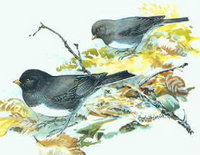| Junco | ||||||||||||
|---|---|---|---|---|---|---|---|---|---|---|---|---|
 |
||||||||||||
| Scientific classification | ||||||||||||
|
The Juncos, genus Junco, comprise three to eight species of small American sparrow.
-
Dark-eyed Junco (Junco hyemalis).
North America, in Canada and much of the United States. Five major races or groups of races,
sometimes treated as species:
- Slate-colored Junco (J. h. hyemalis). North
America in taiga forests from Alaska to Newfoundland
and south to the Appalachian Mountains, wintering
further south.
White-winged Junco (J. h. aikeni). In the Black Hills of South Dakota and Wyoming, United States.
Oregon Junco (J. h. oreganus). The Pacific coast mountains from southeastern Alaska to California.
Pink-sided Junco (J. h. mearnsi). Northern Rocky Mountains from southern Alberta to Idaho and Wyoming.
Gray-headed Junco (J. h. caniceps). Southern Rocky Mountains from Colorado to central Arizona.
- Slate-colored Junco (J. h. hyemalis). North
America in taiga forests from Alaska to Newfoundland
and south to the Appalachian Mountains, wintering
further south.
- Guadalupe Junco (Junco insularis, often treated as a race of J. hyemalis). Guadalupe Island off the west coast of Baja California, Mexico; now rare and endangered.
-
Yellow-eyed Junco (Junco phaeonotus). High
mountains of Mexico, Guatemala, southeastern Arizona and
southwestern New Mexico. Three major races or groups of races:
- Yellow-eyed Junco (Junco phaeonotus phaeonotus).
High mountains of Mexico, southeastern Arizona and
southwestern New Mexico.
Guatemala Junco (Junco phaeonotus alticola). High mountains of Chiapas (southeast Mexico) and Guatemala.
Baird's Junco (Junco p. bairdi). High mountains of Baja California Sur
- Yellow-eyed Junco (Junco phaeonotus phaeonotus).
High mountains of Mexico, southeastern Arizona and
southwestern New Mexico.
- Volcano Junco (Junco vulcani). High mountains of Costa Rica and Panama.
Their breeding habitat is coniferous or mixed forest areas throughout North America, ranging from subarctic taiga to high altitude mountain forests in Mexico and Central America. They usually nest in a well-hidden location on the ground or low in a shrub or tree. Northern birds migrate farther south; southern populations are permanent residents or altitudinal migrants, moving only a short distance downslope to avoid severe winter weather in the mountains.
These birds forage on the ground. In winter, they often forage in flocks. They mainly eat insects and seeds.
"Junco" is the Spanish word for rush (the plant), though these birds are seldom found in rushes.




 216.73.216.91
216.73.216.91 User Stats:
User Stats:
 Today: 0
Today: 0 Yesterday: 0
Yesterday: 0 This Month: 0
This Month: 0 This Year: 0
This Year: 0 Total Users: 117
Total Users: 117 New Members:
New Members:
 216.73.xxx.xx
216.73.xxx.xx
 Server Time:
Server Time: